Creating a healthy sleep environment is crucial, and one effective way to achieve this is by incorporating air-purifying plants into your bedroom.
NASA research has shown that certain plants can remove pollutants and toxins from the air, improving indoor air quality. Some of the best plants for air purification are not only effective but also easy to care for, making them perfect for bedrooms.
By choosing the right plants, you can enhance the air quality in your bedroom, promoting better sleep and overall well-being. In this article, we’ll explore the top indoor plants for clean air that can transform your bedroom into a healthier space.
Key Takeaways
- Air-purifying plants can significantly improve bedroom air quality.
- NASA research supports the effectiveness of certain plants in air purification.
- The top 5 plants are easy to care for and highly effective.
- Incorporating these plants can promote better sleep and overall health.
- Choosing the right plants is crucial for maximizing air purification benefits.
The Science Behind Air Purifying Plants
Understanding how plants purify the air is crucial for appreciating their role in improving indoor air quality. Plants are not just aesthetically pleasing; they are also effective natural air purifiers for bedrooms, capable of removing pollutants and toxins from the air.
How Plants Clean Indoor Air
Plants clean indoor air primarily through the process of photosynthesis. During photosynthesis, plants absorb carbon dioxide and release oxygen, improving the air quality. They also absorb various pollutants and toxins, such as volatile organic compounds (VOCs), through their leaves and roots.
NASA Clean Air Study Findings
NASA’s Clean Air Study investigated the ability of plants to purify indoor air. The study found that certain plants are highly effective at removing pollutants, including VOCs and other toxins. The findings highlighted the potential of plants as natural air purifiers in indoor environments.
| Plant Type | Pollutants Removed | Efficiency |
|---|---|---|
| Spider Plant | VOCs, Formaldehyde | High |
| Peace Lily | Ammonia, Benzene | High |
| Snake Plant | Formaldehyde, Trichloroethylene | Very High |
The study’s results underscore the importance of incorporating plants to improve indoor air quality into our living spaces, particularly in bedrooms where we spend a significant amount of time.
Benefits of Having Air Purifying Plants in Your Bedroom
Incorporating air-purifying plants into your bedroom can significantly enhance indoor air quality and overall well-being. These plants are known to remove pollutants and toxins from the air, contributing to a healthier sleep environment.
Improved Air Quality
Air-purifying plants are effective at removing common indoor air pollutants, such as volatile organic compounds (VOCs) and particulate matter. By improving air quality, these plants can help reduce the risk of respiratory issues and other health problems.
Better Sleep Quality
Having air-purifying plants in the bedroom can also promote better sleep quality. Cleaner air and a healthier environment can lead to more restful and rejuvenating sleep.
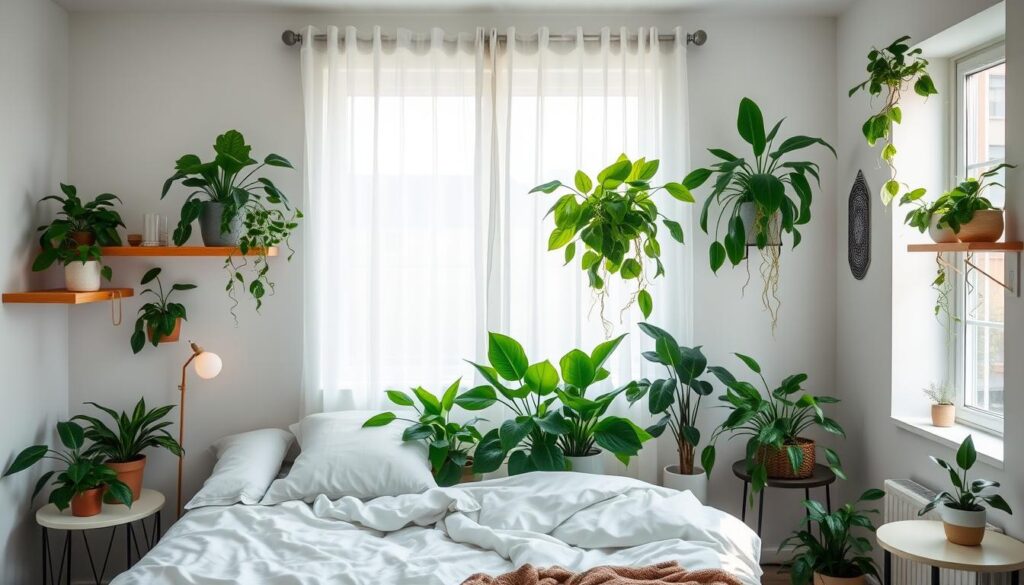
Mental Health Benefits
The presence of plants in the bedroom can have a positive impact on mental health. Studies have shown that being around plants can reduce stress and anxiety, promoting a sense of calm and well-being.
Humidity Regulation
Some air-purifying plants can help regulate humidity levels in the bedroom, which is important for maintaining a comfortable sleep environment. Proper humidity levels can prevent issues like dry skin and congestion.
Common Indoor Air Pollutants
The air inside our homes, especially in bedrooms, can be filled with various pollutants that affect our health and well-being. These pollutants can come from a variety of sources, including household products, furniture, and even the air outside.
Volatile Organic Compounds (VOCs)
Volatile Organic Compounds (VOCs) are chemicals that evaporate easily at room temperature. They can be emitted by various products such as paints, cleaning supplies, and certain types of furniture. Using effective bedroom plants for clean air can help mitigate the effects of VOCs.
Dust and Allergens
Dust and allergens are common indoor air pollutants that can exacerbate respiratory issues like asthma. Regular cleaning and using best plants for bedroom air quality can help reduce these pollutants.
Carbon Dioxide and Carbon Monoxide
Carbon dioxide (CO2) and carbon monoxide (CO) are harmful gases that can accumulate indoors. CO2 can cause drowsiness and decreased productivity, while CO is toxic and can be life-threatening in high concentrations. Proper ventilation and the right plants can help manage these gases.
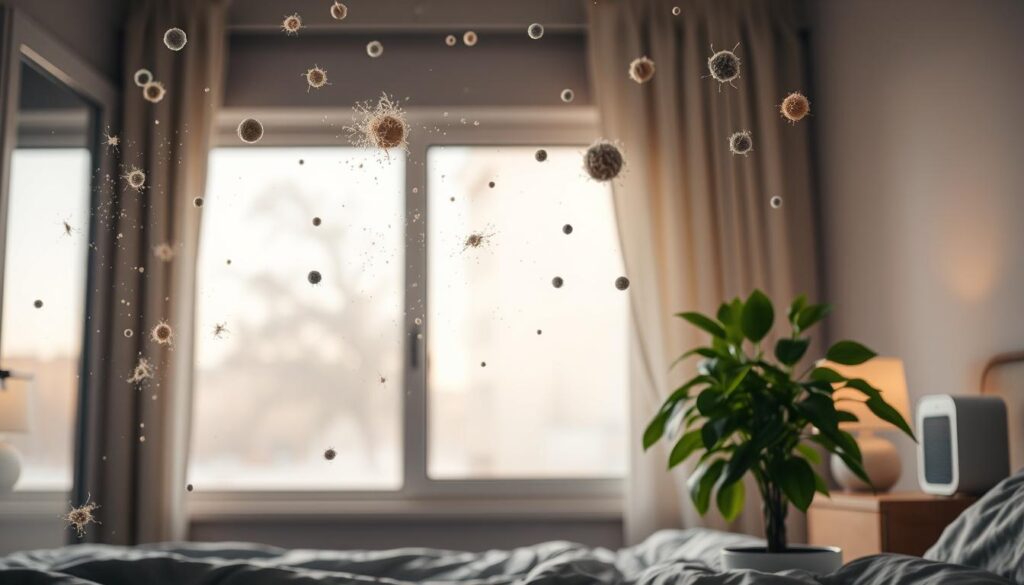
Factors to Consider When Choosing Bedroom Plants
To reap the benefits of having plants in your bedroom, it’s crucial to select the right ones based on specific criteria. Choosing the ideal plants involves considering several factors that ensure they thrive and contribute positively to your indoor environment.
Light Requirements
Different plants have varying light requirements. Some plants, like the Snake Plant, can thrive in low-light conditions, making them perfect for bedrooms with limited natural light. Others, such as the Spider Plant, prefer bright, indirect light. Understanding your bedroom’s light conditions will help you choose plants that will flourish.
Maintenance Level
Some plants require more maintenance than others. For instance, plants like the Peace Lily need regular watering and fertilization, while Pothos is more forgiving if you forget to water it from time to time. Consider how much time you’re willing to dedicate to plant care when making your selection.
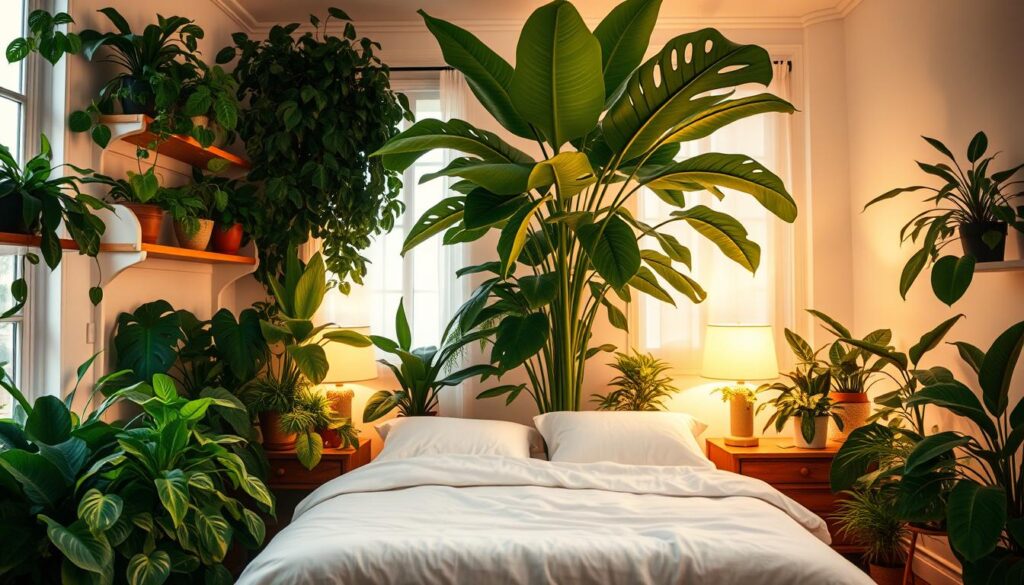
Toxicity to Pets and Children
If you have pets or children, it’s essential to choose plants that are non-toxic to them. Plants like the Rubber Plant can be toxic if ingested, so it’s crucial to keep them out of reach or opt for pet-friendly alternatives.
Size and Growth Habits
Consider the mature size of the plant and its growth habits. Some plants, like the Spider Plant, produce offspring that can be easily propagated, while others may grow quite large and require regular pruning. Understanding the growth habits will help you plan for the future.
| Plant | Light Requirements | Maintenance Level | Toxicity |
|---|---|---|---|
| Snake Plant | Low | Low | Toxic |
| Peace Lily | Medium | Medium | Toxic |
| Spider Plant | Bright, Indirect | Low | Non-Toxic |
Top 5 Air Purifying Plants for Bedrooms
For a healthier bedroom environment, certain plants stand out for their air-purifying abilities. These plants not only beautify the space but also contribute to a cleaner, healthier air quality.
Selection Criteria
The top 5 air-purifying plants were selected based on their efficiency in removing common indoor pollutants, ease of maintenance, and overall health benefits. NASA’s Clean Air Study played a significant role in identifying these plants.
Purification Efficiency Comparison
The selected plants vary in their air-purifying capabilities. Here is a comparison of their efficiency:
- Snake Plant: Removes formaldehyde and benzene
- Peace Lily: Effective against ammonia, benzene, and trichloroethylene
- Spider Plant: Removes air pollutants like formaldehyde and xylene
- Pothos: Known to remove benzene, formaldehyde, and trichloroethylene
- Rubber Plant: Removes airborne toxins like formaldehyde
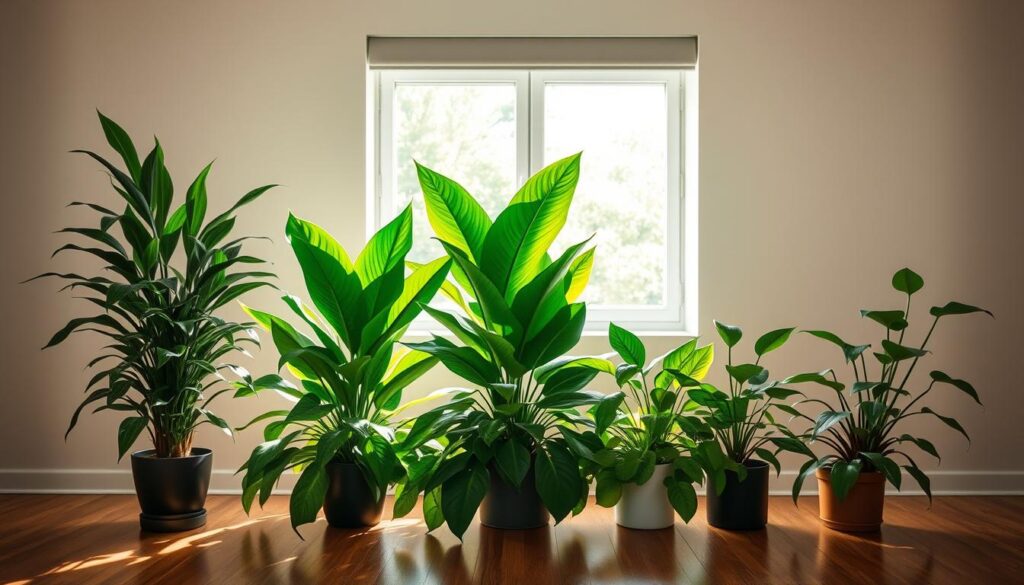
Overall Health Benefits
These air-purifying plants not only improve indoor air quality but also promote better sleep, reduce stress, and boost overall well-being. By incorporating these plants into your bedroom, you can create a healthier sleep environment.
When choosing plants, consider factors like light requirements, maintenance level, and potential toxicity to pets and children to ensure they thrive and benefit your bedroom environment.
Snake Plant (Sansevieria)
As one of the most effective natural air purifiers, the Snake Plant is ideal for bedrooms. This plant is renowned for its ability to remove harmful toxins from the air, improving indoor air quality and contributing to a healthier sleep environment.
Air Purification Benefits
The Snake Plant is a powerful air purifier, capable of removing volatile organic compounds (VOCs) such as formaldehyde and benzene from the air. These pollutants can come from various sources, including furniture, paint, and cleaning products. By having a Snake Plant in your bedroom, you can significantly reduce your exposure to these harmful substances.
Care Requirements
One of the reasons the Snake Plant is so popular is its low-maintenance requirements. To keep your Snake Plant thriving, it’s essential to understand its watering and lighting needs.
Watering Needs
The Snake Plant is drought-tolerant and prefers to dry out between waterings. Overwatering can lead to root rot, so it’s crucial to water sparingly, especially during the winter months when the plant is dormant.
Light Requirements
While the Snake Plant can tolerate low light, it will thrive in bright, indirect light. Direct sunlight can cause the leaves to become scorched, so it’s best to place the plant near a window with filtered sunlight.
Ideal Placement in Bedrooms
To maximize the benefits of the Snake Plant, place it in a spot where it can receive the right amount of light. Bedrooms with north-facing windows are ideal, as they provide gentle, indirect light. You can also place the plant on a bedside table or dresser to create a calming atmosphere.
Troubleshooting Common Issues
If your Snake Plant is turning yellow or brown, it may be due to overwatering or exposure to extreme temperatures. Adjust your watering schedule and ensure the plant is kept in a room with a stable temperature between 65-75°F (18-24°C).
Peace Lily (Spathiphyllum)
The Peace Lily is a popular choice for bedrooms due to its elegant appearance and air-purifying capabilities. This plant is not only aesthetically pleasing but also effective in improving indoor air quality.
Air Purification Benefits
The Peace Lily is known for its ability to remove toxins such as benzene, trichloroethylene, and ammonia from the air. It is also effective in reducing airborne mold and mildew, making it a great addition to bedrooms.
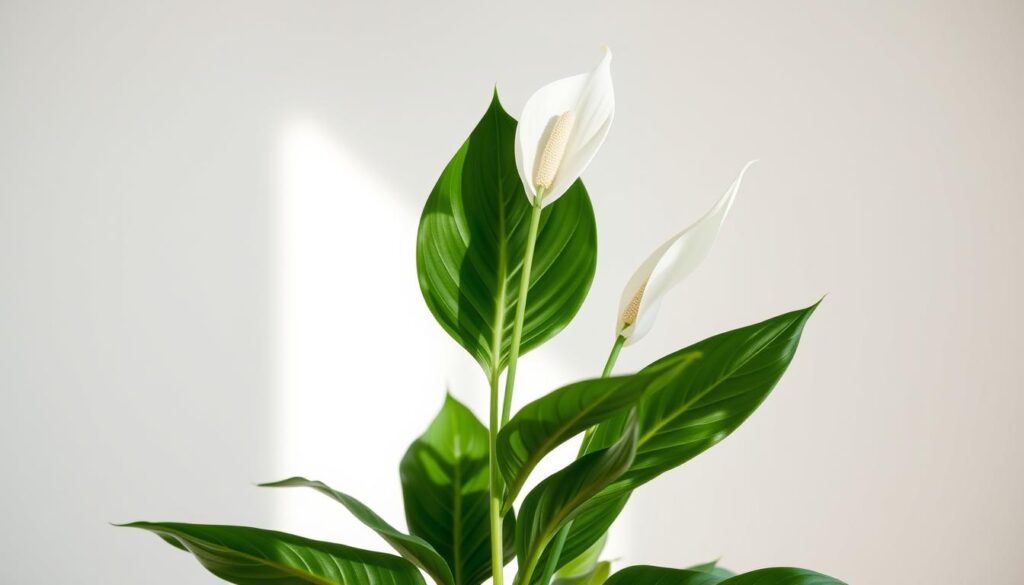
Care Requirements
To keep your Peace Lily thriving, it’s essential to understand its care requirements. This includes understanding its watering and light needs.
Watering Needs
The Peace Lily prefers well-draining soil and should be watered thoroughly, allowing the soil to dry slightly between waterings. Overwatering can lead to root rot, so it’s crucial to avoid waterlogging.
Light Requirements
Peace Lilies can thrive in low-light conditions, making them ideal for bedrooms with limited natural light. However, they can also tolerate bright, indirect light, which can encourage blooming.
Ideal Placement in Bedrooms
For optimal benefits, place your Peace Lily in a spot that is away from direct sunlight and drafts. A corner or against a wall can be an ideal location, allowing the plant to purify the air effectively.
Troubleshooting Common Issues
Common issues with Peace Lilies include yellowing leaves, which can be a sign of overwatering, and brown tips, which may indicate underwatering or exposure to extreme temperatures. Adjusting care routines can help resolve these issues.
By understanding and meeting the Peace Lily’s care requirements, you can enjoy its air-purifying benefits and beautiful blooms, enhancing the quality of your bedroom environment.
Spider Plant (Chlorophytum comosum)
The Spider Plant, or Chlorophytum comosum, is renowned for its efficiency in cleaning indoor air, making it one of the best plants for bedroom air quality. This plant is not only aesthetically pleasing with its cascading leaves and white flowers, but it also offers numerous health benefits.
Air Purification Benefits
The Spider Plant is known to remove various indoor air pollutants, including formaldehyde and xylene. By having this plant in your bedroom, you can significantly improve the air quality, contributing to a healthier sleep environment.
Care Requirements
To ensure your Spider Plant thrives, it’s essential to understand its care needs.
Watering Needs
Water your Spider Plant thoroughly, allowing the soil to dry slightly between waterings. Overwatering can lead to root rot, so it’s crucial to maintain a balance.
Light Requirements
The Spider Plant prefers bright, indirect light but can tolerate partial shade. Direct sunlight should be avoided as it can cause the leaves to become scorched.
Ideal Placement in Bedrooms
Place your Spider Plant in a hanging basket or on a high shelf to maximize space and allow its cascading leaves to be fully appreciated. It’s also advisable to position it near a window with filtered sunlight.
Troubleshooting Common Issues
- Yellowing Leaves: This can be a sign of overwatering or exposure to direct sunlight.
- Brown Tips: Typically caused by dry air or inadequate watering.
- Pests: Check regularly for spider mites and mealybugs, and treat promptly if necessary.
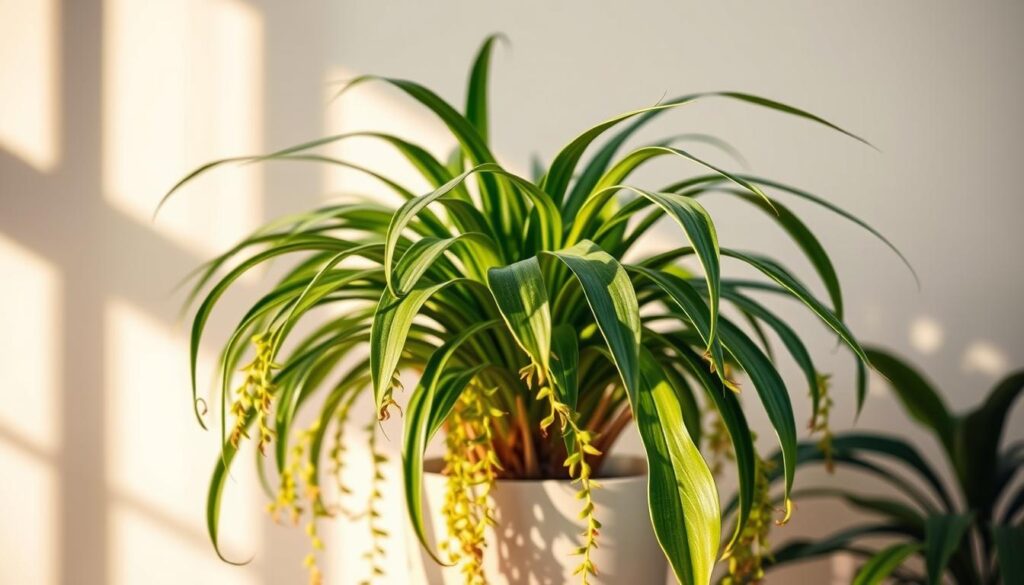
By following these care tips and understanding the benefits of the Spider Plant, you can enjoy cleaner air and a more beautiful bedroom environment. This plant is truly one of the top indoor plants for clean air, making it a great choice for any bedroom.
Pothos (Epipremnum aureum)
Pothos, known scientifically as Epipremnum aureum, is a versatile and efficient air-purifying plant ideal for bedrooms. This plant is not only aesthetically pleasing with its heart-shaped leaves, but it also serves as a natural air purifier for bedrooms, enhancing indoor air quality.
Air Purification Benefits
Pothos is renowned for its ability to remove common indoor air pollutants, including formaldehyde, benzene, and trichloroethylene. By incorporating Pothos into your bedroom, you can significantly improve the air quality, contributing to a healthier sleep environment.
Care Requirements
To ensure your Pothos thrives, it’s essential to understand its care requirements. This includes appropriate watering and light exposure.
Watering Needs
Pothos prefers well-draining soil and should be watered when the top inch of soil feels dry. Overwatering can lead to root rot, so it’s crucial to avoid waterlogging.
Light Requirements
While Pothos can tolerate a range of lighting conditions, it thrives best in bright, indirect light. Direct sunlight can cause leaf scorch, so a spot with filtered sunlight is ideal.
Ideal Placement in Bedrooms
Pothos can be placed on a bedside table, shelf, or even hung from the ceiling, making it a versatile option for bedroom decor. Its trailing vines can add a decorative touch while purifying the air.
Troubleshooting Common Issues
Common issues with Pothos include yellowing leaves, which can be a sign of overwatering, and leggy growth, often due to insufficient light. Adjusting care practices can help mitigate these issues.
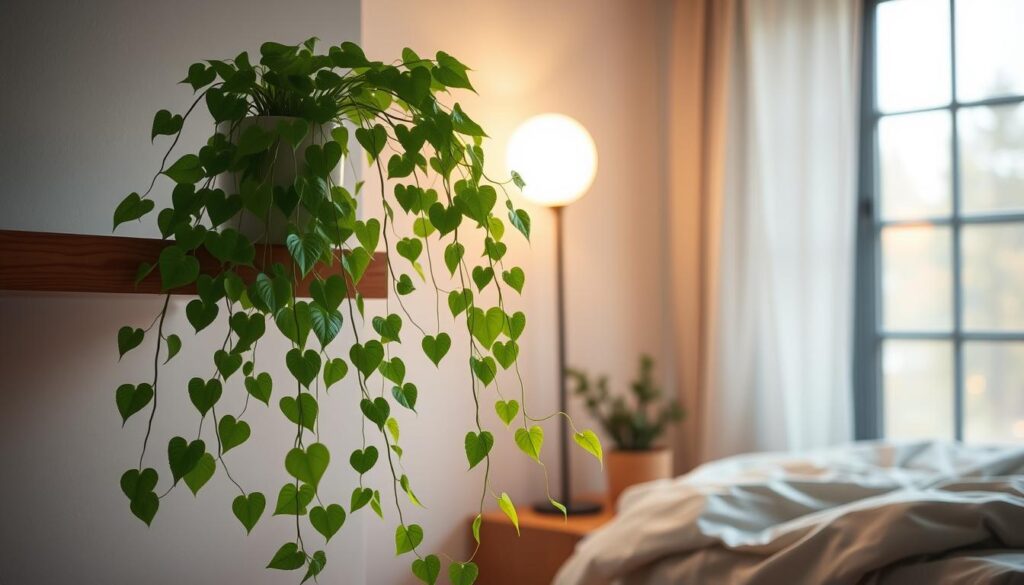
By understanding and addressing the needs of your Pothos, you can enjoy the benefits of this effective indoor plant for better air quality, enhancing your bedroom’s ambiance and air quality.
Rubber Plant (Ficus elastica)
As one of the best air purifying plants for bedrooms, the Rubber Plant offers a natural solution to cleaner air. With its large, dark green leaves, it’s not only a stylish addition to any room but also an effective air purifier.
Air Purification Benefits
The Rubber Plant is known for its ability to remove air pollutants, improving indoor air quality. It is particularly effective at removing formaldehyde, a common indoor pollutant, from the air.
Care Requirements
To keep your Rubber Plant thriving, it’s essential to understand its care needs. This includes:
Watering Needs
The Rubber Plant prefers well-draining soil and should be watered thoroughly, allowing the top inch of soil to dry out between waterings. Overwatering can lead to root rot.
Light Requirements
While it can tolerate low light, the Rubber Plant prefers bright, indirect light. Direct sunlight can cause leaf scorch, so it’s best to place it near an east- or west-facing window.
Ideal Placement in Bedrooms
For optimal benefits, place the Rubber Plant in a spot that is easily visible from your bed but not so close that it interferes with your sleep. A corner or a dresser top can be an ideal location.
Troubleshooting Common Issues
Common issues with the Rubber Plant include yellowing leaves, often due to overwatering, and leaf drop, which can be caused by sudden changes in temperature or humidity. Adjusting care routines can help mitigate these issues.
| Care Aspect | Recommendation |
|---|---|
| Watering | Water thoroughly, allowing top inch of soil to dry |
| Light | Bright, indirect light; avoid direct sunlight |
| Humidity | Average humidity; can adapt to normal indoor levels |
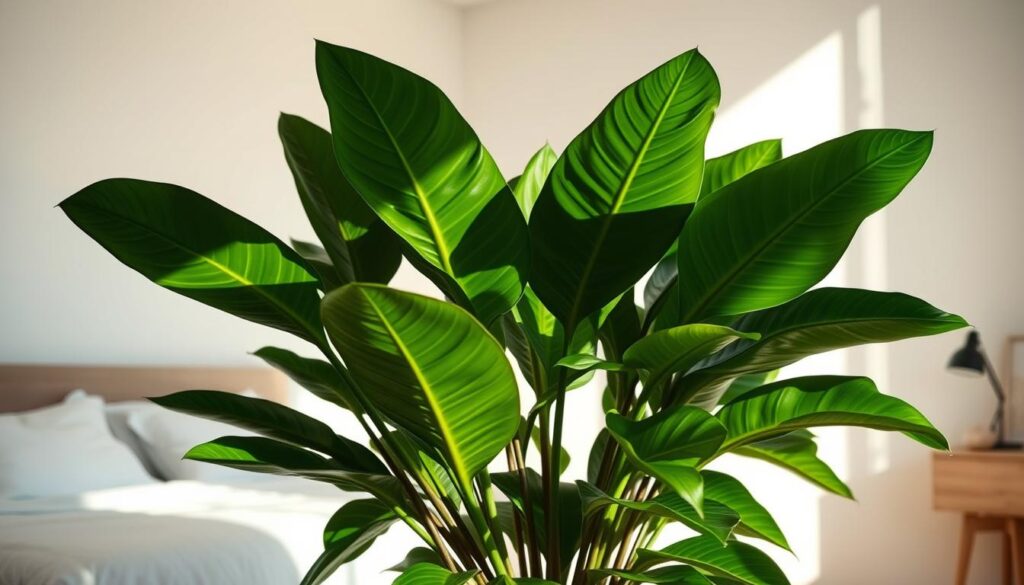
Seasonal Care for Bedroom Plants
As the seasons change, the needs of your bedroom plants also shift, requiring adjustments in care to maintain their air-purifying benefits. To keep your plants thriving, it’s crucial to understand and respond to these seasonal changes.
Winter Care Tips
During winter, the dry air and reduced light can stress your plants. To mitigate this, ensure you’re not overwatering, as the dry air can cause the soil to dry out more slowly. Also, consider using a humidifier to maintain a comfortable humidity level for your plants.
Summer Adjustments
In the summer, plants generally require more water due to increased evaporation and growth. However, be cautious not to overwater, as this can lead to root rot. Additionally, consider moving plants to brighter locations or using grow lights to supplement the natural light.
Seasonal Growth Patterns
Understanding the growth patterns of your plants during different seasons can help you tailor their care. Most plants experience active growth in spring and summer, requiring more frequent watering and fertilization. In fall and winter, growth slows, and care should be adjusted accordingly.
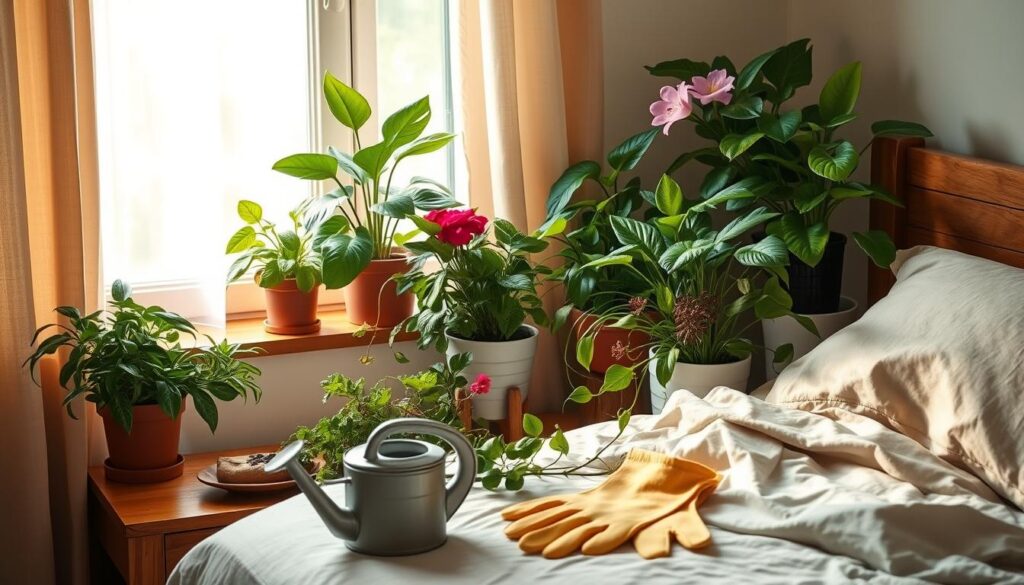
Conclusion
Incorporating air-purifying plants into your bedroom can significantly improve indoor air quality, promoting a healthier sleep environment. The top 5 air purifying plants for bedrooms, including Snake Plant, Peace Lily, Spider Plant, Pothos, and Rubber Plant, are not only effective at removing pollutants but also easy to care for.
These best plants for air purification offer a range of benefits, from reducing volatile organic compounds (VOCs) and dust to regulating humidity levels. By choosing the right plants for your bedroom, you can create a more comfortable and restful space that supports overall well-being.
By integrating these top 5 air purifying plants for bedrooms into your daily routine, you can enjoy improved air quality, better sleep quality, and a range of mental health benefits. Whether you’re looking to enhance your bedroom’s ambiance or simply seeking a natural way to purify the air, these plants are an excellent choice.



